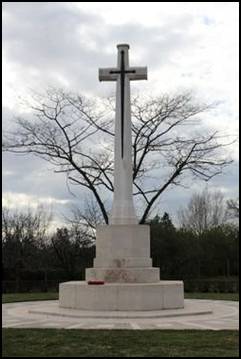
1869550 Company Quartermaster Sergeant
JAMES
MARSHALL
Royal Engineers
by
Lieutenant Colonel Edward De Santis, MSCE, P.E.,
MInstRE
U.S. Army Corps of Engineers
February 2022

Figure 1. The Cross at the Naples War
Cemetery.
(Image courtesy of Wikipedia)
INTRODUCTION
Research into the life and military service of James Marshall was difficult. The surname Marshall is a relatively common one. In addition, without a middle name or initial searching for him on Ancestry.com or some other source of genealogical data was extremely difficult and time consuming. Even knowing his exact date of birth and death did not help in locating a family tree for him on Ancestry.com or in the London Gazette. The Commonwealth War Graves Commission memorial site did not indicate the name of his parents or a spouse, if any. Most of the information presented below has come from his Royal Engineers Tracer Cards and virtually no personal or family information has been located.
This research project was undertaken because the author acquired a medal won by Marshall at the School of Military Engineering during his recruit training. He was awarded the Royal Engineers Training Battalion bronze medal as the 4th Best Man in Physical Training in his unit. This medal will be described in more detail in a subsequent section.
EARLY LIFE AND FAMILY INFORMATION
According to his R.E. Tracer Cards James Marshall was born in Linlithgowshire (or Linlithgow), West Lothian, Scotland on 23 April 1914. It was historically West Lothian's county town, reflected in the county's historical name of Linlithgowshire. An ancient town, it lies in the Central Belt on an historic route between Edinburgh and Falkirk beside Linlithgow Loch. The town is situated approximately 20 miles west of Edinburgh.
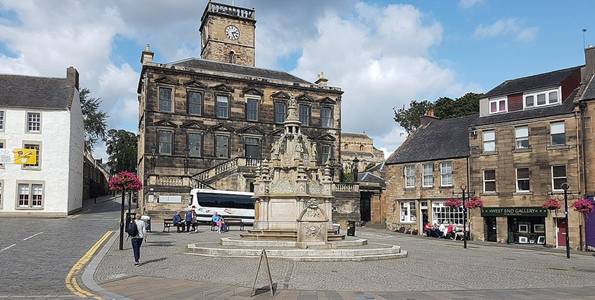
Figure 2. Linlithgow Town
Center.
(Photograph courtesy of Kirknewton & East
Calder, West Lothian)
No additional information was uncovered during this research regarding James Marshall’s early life or family information. A wide range search for him in Linlithgow with a birth date in 1914 produced no results. Either his place of birth shown on the tracer cards is in error or his birth was never registered Scotland or anywhere in the United Kingdom. A request for his service papers, if they exist at the Army Personnel Centre (APC) in Glasgow, could provide more personal information about him and certainly more military information. These papers have not yet been requested because of the limited number of people working at the APC in 2020 and 2021 because of the COVID virus. An attempt to get these records may be made once it becomes evident that the APC is back to full staff.
PHYSICAL DESCRIPTION
Since James Marshall’s military records were not obtained for this study, no physical description of him was available.
4. ENLISTMENT AND TRAINING
Enlistment
James Marshall enlisted as a Boy Soldier on 14 January 1929 at the age of 14 years and 9 months. At the time of his attestation he was assigned Army Number 1869550. His period of engagement was 8 years with the Colours and 4 years in the Army Reserve.
Training
Chepstow (1929-1932)
As a Boy Soldier he was posted to the Army Training School (Boys) at Chepstow in Wales. The Army Training School, Chepstow, was set up as a central training school for boys on September 25th 1923. It was originally based at Aldershot but moved to Beachley in Gloucestershire on 28 February 1924 and was renamed the Boy’s Technical School. The school went through several name changes and in 1929, just when Marshall was posted there, the name changed to the Army Technical School (Boys). While at the school Marshall received some military training, education and common core skills, leadership, character development and trade training.
Chatham (1932)
On 19 January 1932, just prior to his 18th birthday, Marshall was posted to “A” Company of the Royal Engineers Training Battalion (R.E.T.B.) at Chatham, Kent and was assigned to 151 Party. The officer commanding the training battalion at that time was Lieutenant Colonel W. Cave-Brown, R.E.[1] His company commander was Captain S.St.D. Skinner, R.E. The other officers in “A” Company during the time that Marshall received his recruit training were:
· Lieutenant Eric Croghan, R.E.[2]
· Lieutenant W.R.G. Walker, R.E.
· Lieutenant J. Murray, R.E.
· Lieutenant G.O.M. Jameson, R.E.[3]
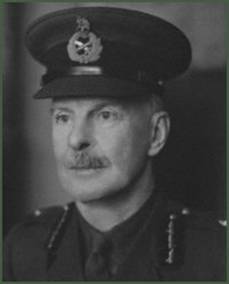
Figure 3. W. Cave-Brown as a Major
General.
(Photograph courtesy of Wikipedia)
Upon turning 18 years of age Marshall was admitted to the ranks of the Corps of Royal Engineers as a Sapper. His training began with the basics that were required for each man to learn to be a soldier, some of which he had already learned at Chepstow. This involved military customs, the wearing of his uniform and insignia, military discipline and the use, care and maintenance of his weapon, the short, magazine Lee-Enfield rifle (SMLE). Following a period of basic training, Foster then received the training necessary to make him an engineer soldier. This involved such field engineering subjects as tunnelling, trench-building, camouflaging techniques, barbed-wire entanglements, construction and clearing of obstacles, bridging, explosives and demolitions and other skills necessary to support the infantry and artillery in the field. Upon completion of his training Sapper Marshall was designated an Electrician, Class AIII.
5. POSTINGS, ASSIGNMENTS AND CAMPAIGN SERVICE
North Queensferry (1932-1933)
Upon the completion of his training at Chatham, Sapper Marshall was posted to the 49th (Fortress) Company at North Queensferry in Fife, Scotland. This company was part of the Scottish Command and it shared the barracks at North Queensferry with a detachment of the Royal Engineers Survey Battalion.[4] The officer commanding the 49th (Fortress) Company when Marshall joined the unit was Captain N.E.V. Patterson, R.E.[5]
The role of a fortress company was to assist in the defence of ports and harbours that had significant military importance. This was accomplished by the use of mines and searchlights and by supporting the Royal Artillery garrison co-located with the fortress company. A Royal Engineers fortress company typical would provide the following services in defence of ports and harbours:
Construction and maintenance of fortifications and gun emplacements.
Construction of ammunition storage areas and magazines.
Construction and maintenance of roadways.
Water supply to units manning the fortifications.
Supply of electricity to installations within the fortress area.(*)
Provide searchlight support to anti-aircraft and anti-shipping artillery batteries.(*)
Provide engineer works in and around the harbour and port areas.
(*) As an Electrician, Marshall would have been part of the company that provided electricity to the installations buildings and searchlights.

Figure 4. The Royal Engineers Barracks at
North Queensferry, Fife.
(Photograph courtesy of Wikipedia)
Gosport (1933)
Sapper Marshall remained with the 49th (Fortress) Company for about 6½ months when he was posted to the 4th (Fortress) Company at Gosport on the southern coast of England in Hampshire on 22 April 1933. The company was part of the Southern Command, Wessex Area (East) and was stationed at Haslar Barracks.[6] The company O.C. was Major Maurice Luby, DSO, MC, R.E.[7] The company’s second in command (2IC) was Captain Robert Denis Keane, R.E.[8] and other officers in the 4th (Fortress) Company included:
· Lieutenant N.R. Swales, R.E.[9]
· Lieutenant John T.S. Tutton, R.E.[10]
· Lieutenant C.F.W. Miller, R.E.[11]
· Lieutenant Arthur Talbot Godfrey, R.E.[12]
Marshall’s duties in the 4th (Fortress) Company would have been much the same as they had been with the 49th (Fortress) Company.
Figure 5. Robert Denis Keane as a
Brigadier. |
Figure 6. John T.S. Tutton as a
Brigadier. |
Figure 7. Arthur Stuart Godfrey as a
|
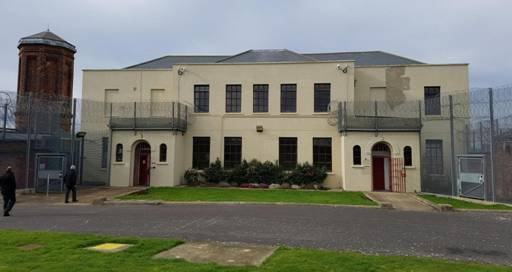
Figure 8. Haslar Barracks, Gosport,
Hampshire.
(Photograph courtesy of Wikipedia)
Blackdown (1933-1934)
On 21 July 1933, only 3 months after his posting to the 4th (Fortress) Company, Marshall was posted to “C” Company, 1st Anti-Aircraft Searchlight (1st AASL) Battalion in Blackdown, Hampshire. At the time of Marshall’s posting the battalion was commanded by Lieutenant Colonel Maurice Fitzgibbon Grove-White, DSO, OBE, R.E.[13] and “C” Company was commanded by Captain Albert James de Pury, R.E.[14]([15])
Figure 9. Maurice Fitzgibbon Grove-White as
a Lieutenant General. |
Figure 10. Albert James de Pury as a
Lieutenant Colonel, R.E.
|
On 1 April 1935 Marshall was posted to “A” Company, 1st AASL Battalion which also was at Blackdown. His new company commander was Major K.D. Yearsley, MC, R.E.[16] He remained with this unit for only five months and then was posted abroad to Malta.
Malta (1934-1937)
When Sapper Marshall arrived in Malta he joined the 16th Anti-Aircraft Searchlight Company on 7 September 1934. This was a separate anti-aircraft searchlight company that was not associated with any larger unit. The company commander was Captain David Cowie, R.E.[17] The only other officer assigned to the company at that time was Lieutenant John Benedict Heywood-Waddington, R.E.[18] Marshall’s posting to this company was undoubtedly due to his trade as an Electrician and to his prior experience with the 1st AASL Battalion at Blackdown. In 1935 the 16th AASL Company was converted to the 16th (Fortress) Company, another type of unit with which Marshall had considerable experience.
On 1 June 1937 Sapper Marshall was appointed a Lance Corporal. On 5 November 1938 he was promoted to the substantive rank of Corporal. He remained on the island of Malta until late in 1938 when he was posted home.
Chatham (1938-1939)
On 17 December 1938 Corporal Marshall joined Headquarters Wing of the R.E. Training Battalion at Chatham. He remained in the HQ Wing of the battalion until 8 March 1939 when he was posted to “D” Company. His duties in the HQ Wing must be assumed to have been administrative. His duties in “D” Company probably were as an assistant instructor or an instructor in electricity-related subjects, perhaps dealing with searchlight operation, repair and maintenance. As 1940 approached the Royal Engineers prepared to relinquish the role of anti-aircraft searchlight operations to the Royal Artillery. By that time the searchlight commitment within the Corps of Royal Engineers had become considerable and began to conflict operationally with the role of the Royal Artillery and Royal Air Force. Additionally, the anti-aircraft searchlight work distracted the Corps from its true role of military engineering. Just as the Royal Flying Corps, the Tanks, the Royal Corps of Signals and others had in due course been born in the Corps of Royal Engineers and had gone their own way, so did the anti-aircraft searchlight mission. Pressures from the Royal Artillery to take over the entire anti-aircraft searchlight role in 1940 were not resisted by the Royal Engineers, except by units that did not relish being converted once again to another corps. However, the conversion of 27 anti-aircraft battalions of the Royal Engineers into searchlight regiments of the Royal Artillery was completed by early 1941, at which point the enormously important and successful story of the anti-aircraft searchlights in the Royal Engineers had come to an end. Marshall’s next postings reflected the removal of men of the Royal Engineers from the regular anti-aircraft searchlight establishment.
Ripon (1939-1941)
On 1 September 1939 Marshall was posted to the Militia Training Battalion at Ripon in North Yorkshire. In June of 1939 a Militia Training Battalion had been formed in Catterick with three squadrons. The Antiaircraft Militia Training Battalion was also formed in Harrogate on a tented site. In September 1939 1st Operators Training Battalion (OTB) was formed with four companies. Its staff comprised mainly Territorials augmented by Reservists, Regulars and Militiamen. This appears to be the unit that Marshall joined. He remained with this unit until 8 June 1941 when his tracer card indicates that he was posted to the I.S.R.B.[19]
During the research for this study of Marshall’s service, no information was uncovered to indentify this unit. Similarly, on 10 June 1941 and 18 June 1941 he was posted to Special Training School 41 and Special Training School 46, respectively. The following may be a gross assumption on the author’s part, but the Special Training Schools mentioned may have been a part of the Special Operations Executive, which lists numerous such special schools as part of its establishment.[20] Although the purpose of each school is not known, STS 41 was in Gumley Hall, in Market Harborough, a town in the Harborough district of Leicestershire, forming part of the border with Northamptonshire. What went on at STS 41 is not known. STS 46 was located in Chichely Hall, Buckinghamshire and was the Czechoslovak Section of the SOE. Is it possible that Marshall was being trained as a behind-the-lines special operator? If he was being so trained there is no evidence on his tracer cards to indicate that he performed any missions in that regard. His complete service papers may shed more light on this.
Italy
(1942-1944)
On 22 December 1942 Marshall was posted to the 551st Army
Troops Company, R.E., which was serving with the Mediterranean
Expeditionary Force (M.E.F.). He joined the unit on 7 January
1943. The 551st Army Troops Company had been
activated in September 1940 and was immediately nominated for
overseas service. The company had arrived in North Africa
about December 1940. It was in Egypt by January of 1941 and
under the Cairo Base Sub-Area by end of that month. As a corps
unit it destroyed installations in the retreat to the Egyptian
frontier and was part of the Tobruk Fortress from April to November
of 1941. The other units of the Royal Engineers taking part in
this operation were the 295th Army Field Company and the
552nd Army Troops Company. They destroyed installations
and port equipment and jetties at Bardia and Sollum and assisted
other engineer units in cratering roads and destroying water supply
installations. In Tobruk, with Royal Australian Engineers units
of the 9th Australian Division, the 551st Army
Troops Company worked on defensive positions, maintained two water
wells and a distilling plant and kept the electric power plant at
Tobruk in operation during the siege. The company also repaired
bomb craters in the port area.[21]
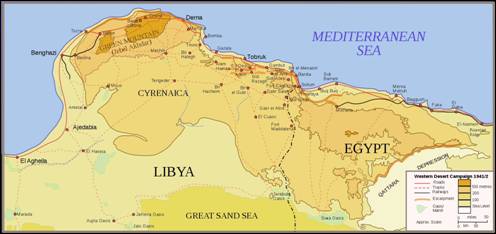
Figure 11. The Western Desert Campaign,
1941/1942
(Image courtesy of Wikipedia)
The company served with the Eighth Army at Gazala in May of 1942 and again in February of 1943. Marshall joined the company while it was at or near Gazala, so he missed the action at Tobruk. The 551st Army Troops Company was with the Eighth Army when it invaded the Italian mainland on 3 September 1943. The invasion coincided with an armistice made with the Italians who re-entered the war on the Allied side. Allied objectives were to draw German troops from the Russian front and more particularly from France, where an offensive was planned for the following year.
Marsall’s tracer card contains an unexplained notation (HST) for him dated 12 November 1943. It is thought that he may have been in hospital at that time. On 15 December 1943 he was posted to the 4th Battalion, 1st General Reinforcement Training Depot (4 BN, 1G.R.T.D.) and on 5 January 1944 he returned to duty with the 551st Army Troops Company.[22]
On 15 June 1944 James Marshall was reported as a battle casualty. His rank at the time of his death was Company Quartermaster Sergeant (CQMS). Although he was recorded as a battle casualty, his tracer card shows that he “committed suicide whilst temporarily insane.” The Graves Registration Report Form on which his death was listed shows that he was initially buried at SC3/RGD/2079, the designation of his temporary grave. On 15 September 1944 he was reburied in the Naples War Cemetery, Plot 1, Row M, Grave 18. His grave is marked only with a cross headstone without any family inscription or commemoration. The Naples War Cemetery contains 1,202 Commonwealth burials of the Second World War.
The 65th and 92nd General Hospitals were in Naples from late in 1943 until the end of the war. The 67th General Hospital also was located there for the greater part of that time. The site for the war cemetery was chosen in November 1943 and burials were made in it from the hospitals and garrisons. Later graves were brought in from a number of small cemeteries in the immediate vicinity. It would appear that SC3/RGD/2079 was Marshall’s initial grave location in one of these smaller cemeteries in the vicinity of where his death occurred. No reference has been uncovered to indicate where his initial grave location may have been.
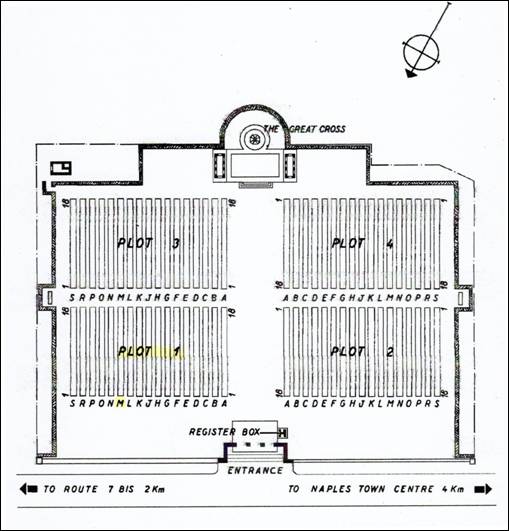
Figure 12. Naples War Cemetery
(Image
courtesy of the Commonwealth War Graves Commission)
Although no information was found during this research project regarding Company Quartermaster Sergeant’s family, he is commemorated on the Parish of Kirknewton and East Calder Memorial in Kirknewton, West Lothian. Although the Army and the CWGC appear to have little information regarding his family, someone from his place of birth remembered him.
The Army Roll of Honour, 1939-1945 indicates that his place of residence at the time of his death was Edinburgh.
6. RELEASE FROM SERVICE
At the time of his death CQMS Marshall’s total service with the Royal Engineers was reckoned as shown in the tables below.
Location |
Period of Service |
Chepstow |
14 January 1929 -18 January 1932 |
Chatham |
19 January 1932 – 3 October 1932 |
North Queensferry |
4 October 1935 – 21 April 1933 |
Gosport |
22 April 1933 – 20 July 1933 |
Blackdown |
21 July 1933 – 6 September 1934 |
Malta |
7 September 1934 – 16 December 1938 |
Chatham |
17 December 1938 – 31 August 1939 |
Ripon |
1 September 1939 – 7 June 1941 |
I.S.R.B. and Special Training Schools |
8 June 1941 -21 December 1942 |
Egypt and Libya |
22 December 1942 – 2 September 1943 |
Italy |
3 September 1943 – 15 June 1944 |
Location |
Period of Service |
Home |
9 years, 7 months and 27 days |
Abroad |
5 years, 9 months and 5 days |
Total Service |
15 years, 5 months and 2 days |
NOTE: The mystery posting to I.S.R.B. may have been a posting to an Intelligence, Surveillance and Reconnaissance Battalion which may or may not have existed at that time. This is purely a guess on the author’s part. Such units do exist in the British Army today, but they were formed under this title well after the Second World War. However, as noted in the text he was posted to two Special Training Schools 41 and 46, which may have been schools of the Special Operations Executive (SOE) at Market Harborough in Leicestershire and at Chichely Hall, Buckinghamshire. Again, these are just guesses on the author’s part, but given the cryptic way that these postings are listed on his tracer cards, he may have been in training for some special operations work.
________________________________________________________________
The following sections are presented in tabular form to summarize Marshall’s promotions, appointments, military training and qualifications and the medals that he may have been awarded during his time in the Army. They are provided to give the reader easy access to these aspects of his military career.
________________________________________________________________________
7. PROMOTIONS AND APPOINTMENTS
James Marshall received the following promotions during his time in service:
Date of Promotion or Appointment |
Rank or Position |
14 January 1929 |
Appointed a Boy Soldier upon enlistment (under age). |
19 January 1932 |
Appointed a Sapper upon reaching age 18. |
1 June 1937 |
Appointed Lance Corporal. |
5 November 1938 |
Promoted Corporal. |
(*) |
Appointed Lance Sergeant. |
(*) |
Promoted Sergeant. |
(*) |
Promoted Staff Sergeant. |
(*) |
Promoted Warrant Officer Class II (Company Quartermaster Sergeant) |
NOTES: (*) The dates of these appointments and promotions are not known. His tracer cards do not provide these dates, but his full service papers probably would.
MEDALS, AWARDS AND DECORATIONS
Based on the information provide in his tracer cards it would appear that CQMS Marshall may have been entitled to the following campaign medals:
· 1939-45 Star
· Africa Star with clasp [8TH ARMY]
· Italy Star
· Defence Medal
· War Medal
Again, his full service papers would verify these awards.
Royal Engineers Training Battalion bronze medal for being the 4th Best Man in Physical Training in his unit is shown below. The obverse of the medal shows the 9-flame grenade of the Royal Engineers over a scroll with the word “UBIQUE” (Latin for “Everywhere”) and below that another scroll with the Corps motto “QUO FAS ET GLORIA DUCUNT” (“Whither right and glory lead”). The medal is 1-3/8 inches in diameter and 1/8 inch thick. The reverse of the medal is engraved with the following:
1869550
SPR
J. MARSHALL
4TH BEST MAN P.T.
151
PARTY
“A” COY R.E.
Figure. 13. Obverse of the R.E.T.B. Medal (Image from the author’s collection) |
Figure 14. Reverse of the R.E.T.B. Medal (Image from the author’s collection) |
9. MARRIAGE, FAMILY AND PERSONAL INFORMATION
Since so little is known of Marshall’s private life, this section contains no definitive information. His service papers would provide information about his parents, siblings, wife and children, if any. An email received some time ago by the author indicated that Marshall did have a daughter out of wedlock, but that information has not been confirmed. Additional information may be added to this narrative if and when Marshall’s service papers can be obtained.
ADDENDUM NO. 1
A birth certificate provided by Monica Leslie indicates that James Marshall was born on 23 April 1914 in the Parish of Uphall in the County of Linlithgow, Scotland. The certificate also indicated that his father was James Marshall, a General Labourer and his mother was Ellen Marshall, née Orr. James and Ellen had been married in Bathgate on 2 June 1908.
*******************************************************************************************************************************************************************************************************************************************
ADDENDUM NO. 2
Monica Leslie also provided a newspaper cutting (newspaper and date unknown) that contained the following information:
__________________________________________________________________________
LOCAL SOLDIER KILLED
Mrs. Marshall, 40 Oakbank, has been notified that her son, C.Q.M.S. James Marshall, R.E. has lost his life in Italy. C.Q.M.S. Marshall had been in the army for 15½ years, eight of which he has spent on foreign service. He joined the Engineers on leaving school, serving his apprenticeship at an R.E. Station in Wales. Throughout the North African campaign he served with the famous “Eighth.” The sympathy of all classes of the community is extended to the bereaved mother and the other members of the family.
__________________________________________________________________________
*******************************************************************************************************************************************************************************************************************************************
ADDENDUM NO. 3
Monica Leslie has determined that Marshall had only two living siblings, Emily and William. Emily and her Cameron family have been traced to the United States. There is also an unconfirmed death of William in Scotland in the 1970s.
*******************************************************************************************************************************************************************************************************************************************
REFERENCES:
Books
PAKENHAM-WALSH, R.P. The History of the Corps of Royal Engineers, 1938-1948. Volume VIII. The Institution of Royal Engineers, Chatham, Kent, 1958.
Internet Web Sites
Find My Past (FMP).
Kirknewton & East Calder, West Lothian
http://warmemscot.s4.bizhat.com/warmemscot-ftopic438.html
List of SOE Establishments
https://en.wikipedia.org/wiki/List_of_SOE_establishments
National Portrait Gallery
https://www.npg.org.uk/collections/search/person/mp80422/sir-maurice-fitzgibbon-grove-white
WW2Talk
http://ww2talk.com/index.php?threads/551-552-army-troops-companies-r-e.53031/
Military Documents
Corrections in Respect to Burials, Sheet 21.
Graves Concentration Report Form (GCRF)
Graves Registration Report Form.
Headstone Schedule “A”.
Royal Engineers Tracer Cards (TC).
Miscellaneous Documents
Army Roll of Honour, 1939-1945 (ARH).
Commonwealth War Graves Commission Debt of Honour (CWGC).
Probate Calendar, 1939-1947, page 46.
Periodicals
The Orders and Medals Research Society Journal, Volume 44.
Royal Engineers Quarterly Lists
Royal Engineers Quarterly List, January 1932, p. xxi.
Royal Engineers Quarterly List, October 1932, p. xxiii.
Royal Engineers Quarterly List, April 1933, p. xxii.
Royal Engineers Quarterly List, July 1933, p. xx.
Royal Engineers Quarterly List, April 1934, p. xx.
Royal Engineers Quarterly List, October 1934, p. xxiii.
Sapper Magazines
The Sapper, March 1939, p. 224.
ENDNOTES:
[1] Later, Major General, CBE, DSO.
[2] Later, Major.
[3] Later, Brigadier. Deceased 23 March 1989.
[4] The Monthly Army List, October 1932.
[5] Later, Brigadier.
[6] The Monthly Army List, April 1933.
[7] Later, Brigadier.
[8] Later, Brigadier. Deceased 16 September 1979.
[9] Later, Lieutenant Colonel.
[10] Later, Brigadier. Deceased 15 January 2000.
[11] Later, Major. Deceased 21 June 1991.
[12] Later, Lieutenant Colonel. Oxford University Expedition to North East Land, 1935-1936. Deceased 1942.
[13] Later, Lieutenant General.
[14] Later, Colonel, MBE. Deceased 1965.
[15] The Royal Engineers List, July 1933).
[16] The Royal Engineers List, April 1934.
[17] Later, Major.
[18] Later, Lieutenant Colonel. Deceased 3 January 1992.
[19] I.S.R.B. could stand for Intelligence, Surveillance and Reconnaissance Battalion, although no such unit was known to exist in the British Army force structure at that time.
[20] List of SOE Establishments.
[21] PAKENHAM-WALSH, 1958, p. 246.
[22] This movement from 12 November 1943 to 5 January 1944 appears to indicate that he left his unit, probably for hospitalization for about a 30 day period, then was posted to the 1st General Reinforcement Training Depot after his recuperation and 20 days later was posted back to his unit: that is, the 551st Army Troops Company.